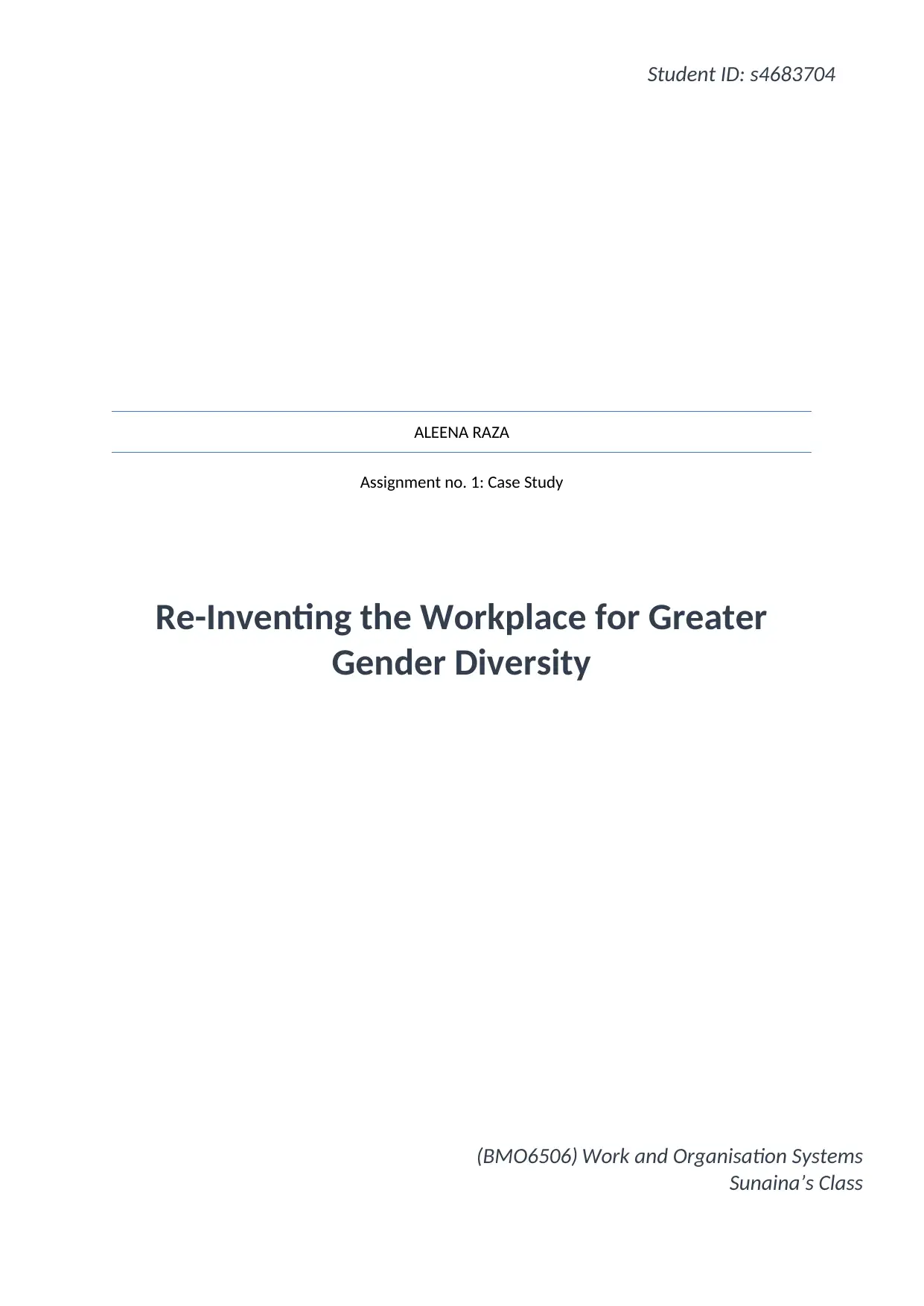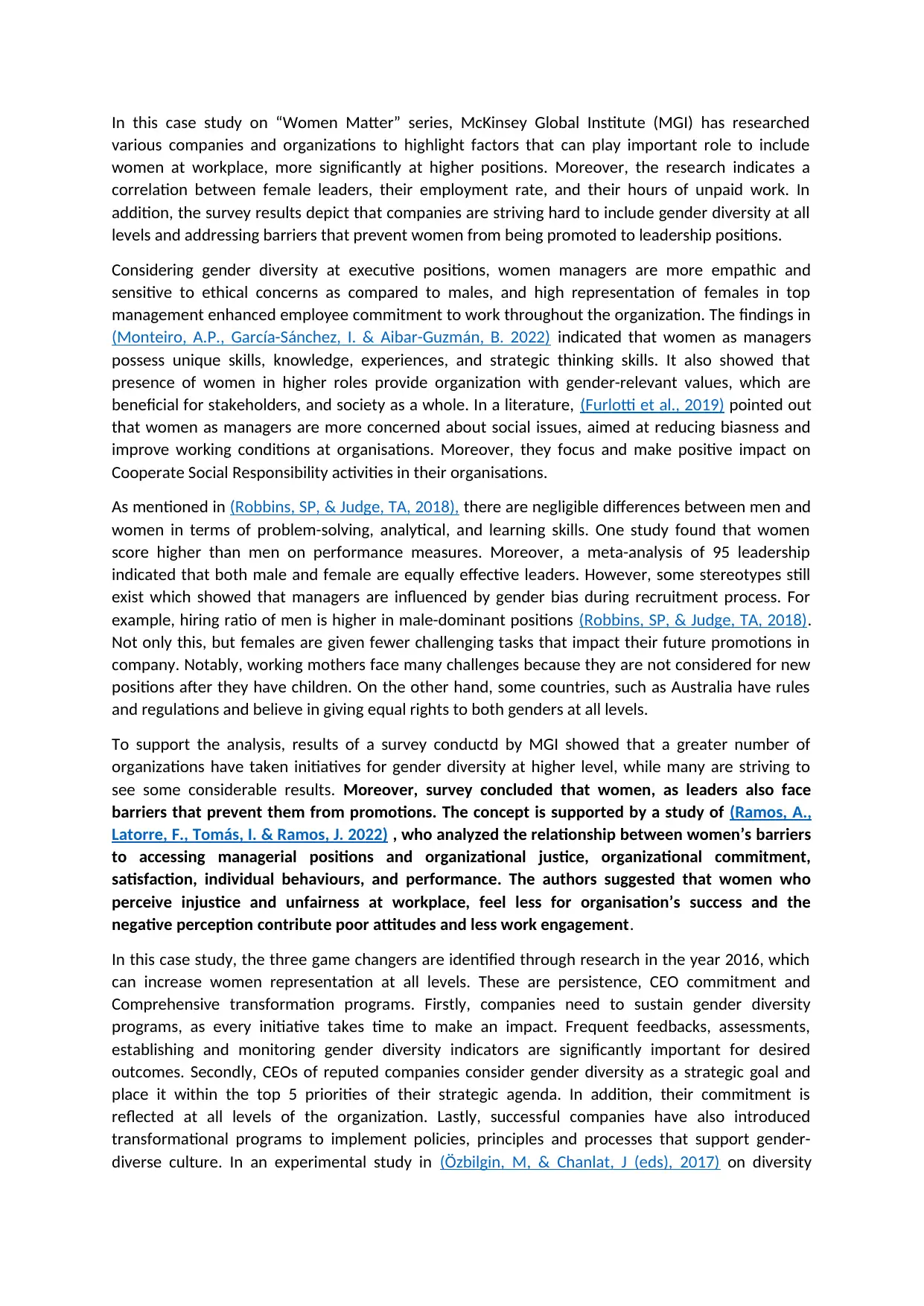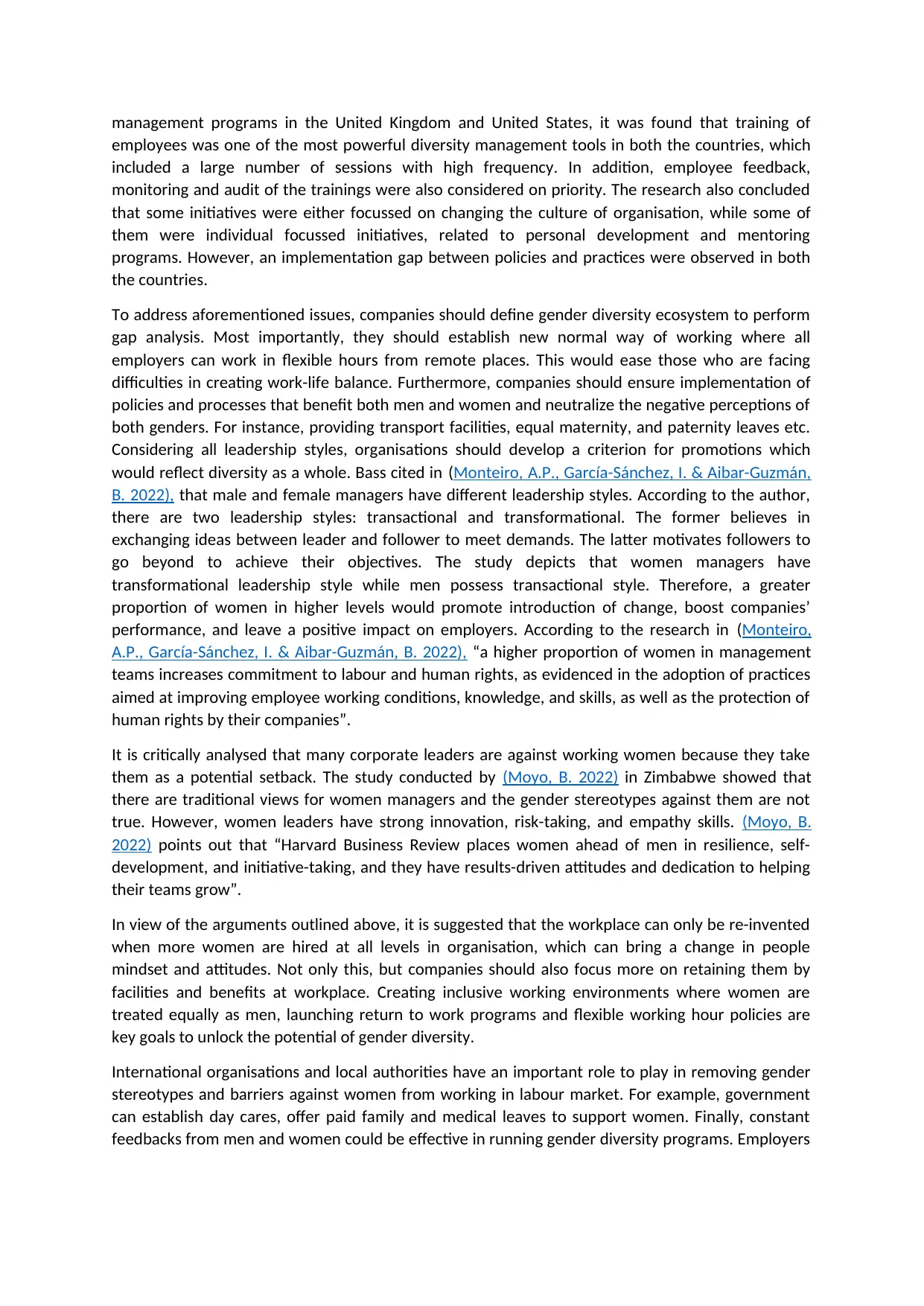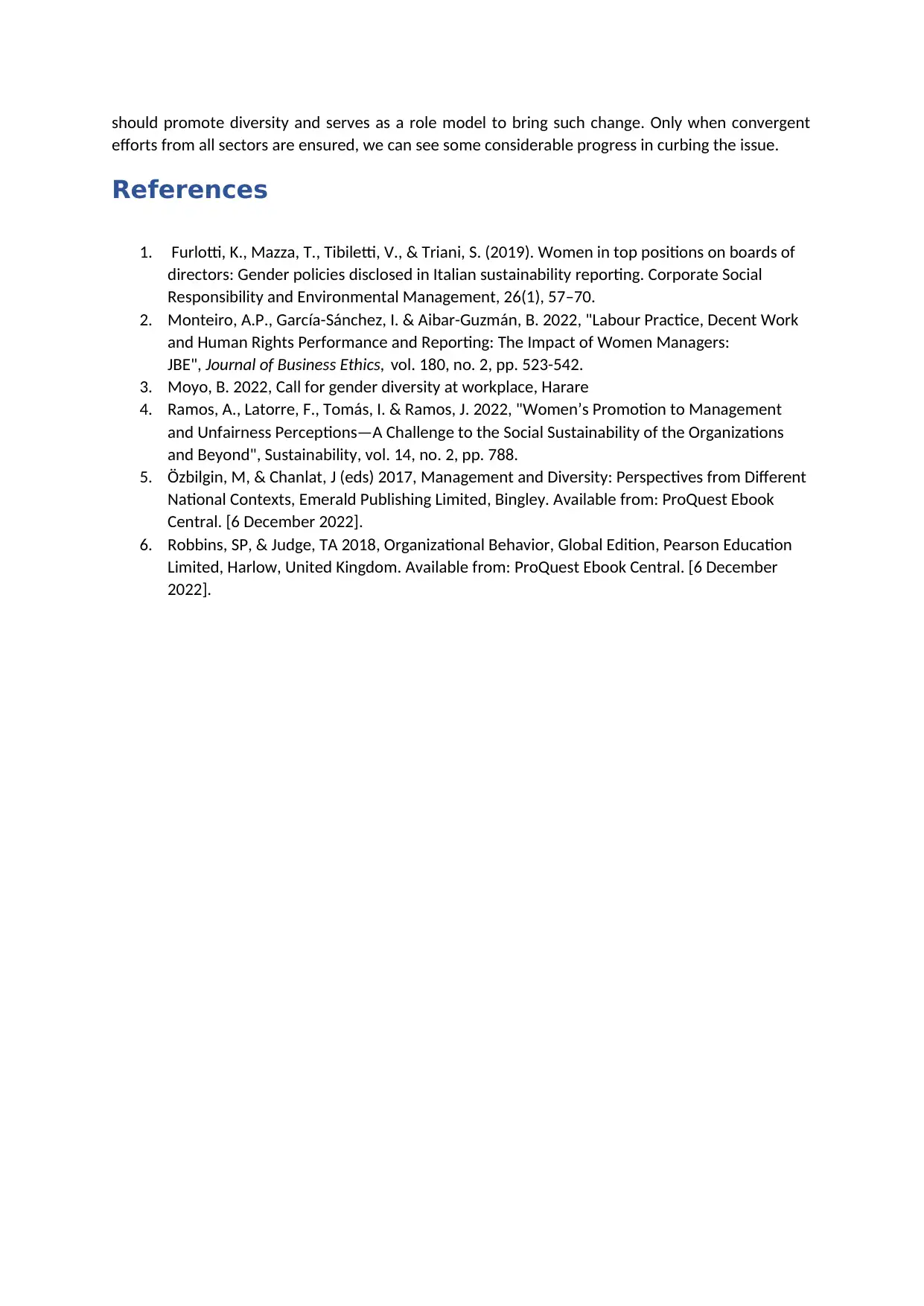Re-Inventing the Workplace for Greater Gender Diversity
VerifiedAdded on 2024/04/20
|4
|1740
|254
AI Summary
This case study explores the importance of gender diversity in the workplace, highlighting the benefits of female leadership, challenges faced by women, and strategies to promote inclusivity and equality.
Contribute Materials
Your contribution can guide someone’s learning journey. Share your
documents today.

ALEENA RAZA
Assignment no. 1: Case Study
Re-Inventing the Workplace for Greater
Gender Diversity
(BMO6506) Work and Organisation Systems
Sunaina’s Class
Student ID: s4683704
Assignment no. 1: Case Study
Re-Inventing the Workplace for Greater
Gender Diversity
(BMO6506) Work and Organisation Systems
Sunaina’s Class
Student ID: s4683704
Secure Best Marks with AI Grader
Need help grading? Try our AI Grader for instant feedback on your assignments.

In this case study on “Women Matter” series, McKinsey Global Institute (MGI) has researched
various companies and organizations to highlight factors that can play important role to include
women at workplace, more significantly at higher positions. Moreover, the research indicates a
correlation between female leaders, their employment rate, and their hours of unpaid work. In
addition, the survey results depict that companies are striving hard to include gender diversity at all
levels and addressing barriers that prevent women from being promoted to leadership positions.
Considering gender diversity at executive positions, women managers are more empathic and
sensitive to ethical concerns as compared to males, and high representation of females in top
management enhanced employee commitment to work throughout the organization. The findings in
(Monteiro, A.P., García-Sánchez, I. & Aibar-Guzmán, B. 2022) indicated that women as managers
possess unique skills, knowledge, experiences, and strategic thinking skills. It also showed that
presence of women in higher roles provide organization with gender-relevant values, which are
beneficial for stakeholders, and society as a whole. In a literature, (Furlotti et al., 2019) pointed out
that women as managers are more concerned about social issues, aimed at reducing biasness and
improve working conditions at organisations. Moreover, they focus and make positive impact on
Cooperate Social Responsibility activities in their organisations.
As mentioned in (Robbins, SP, & Judge, TA, 2018), there are negligible differences between men and
women in terms of problem-solving, analytical, and learning skills. One study found that women
score higher than men on performance measures. Moreover, a meta-analysis of 95 leadership
indicated that both male and female are equally effective leaders. However, some stereotypes still
exist which showed that managers are influenced by gender bias during recruitment process. For
example, hiring ratio of men is higher in male-dominant positions (Robbins, SP, & Judge, TA, 2018).
Not only this, but females are given fewer challenging tasks that impact their future promotions in
company. Notably, working mothers face many challenges because they are not considered for new
positions after they have children. On the other hand, some countries, such as Australia have rules
and regulations and believe in giving equal rights to both genders at all levels.
To support the analysis, results of a survey conductd by MGI showed that a greater number of
organizations have taken initiatives for gender diversity at higher level, while many are striving to
see some considerable results. Moreover, survey concluded that women, as leaders also face
barriers that prevent them from promotions. The concept is supported by a study of (Ramos, A.,
Latorre, F., Tomás, I. & Ramos, J. 2022) , who analyzed the relationship between women’s barriers
to accessing managerial positions and organizational justice, organizational commitment,
satisfaction, individual behaviours, and performance. The authors suggested that women who
perceive injustice and unfairness at workplace, feel less for organisation’s success and the
negative perception contribute poor attitudes and less work engagement.
In this case study, the three game changers are identified through research in the year 2016, which
can increase women representation at all levels. These are persistence, CEO commitment and
Comprehensive transformation programs. Firstly, companies need to sustain gender diversity
programs, as every initiative takes time to make an impact. Frequent feedbacks, assessments,
establishing and monitoring gender diversity indicators are significantly important for desired
outcomes. Secondly, CEOs of reputed companies consider gender diversity as a strategic goal and
place it within the top 5 priorities of their strategic agenda. In addition, their commitment is
reflected at all levels of the organization. Lastly, successful companies have also introduced
transformational programs to implement policies, principles and processes that support gender-
diverse culture. In an experimental study in (Özbilgin, M, & Chanlat, J (eds), 2017) on diversity
various companies and organizations to highlight factors that can play important role to include
women at workplace, more significantly at higher positions. Moreover, the research indicates a
correlation between female leaders, their employment rate, and their hours of unpaid work. In
addition, the survey results depict that companies are striving hard to include gender diversity at all
levels and addressing barriers that prevent women from being promoted to leadership positions.
Considering gender diversity at executive positions, women managers are more empathic and
sensitive to ethical concerns as compared to males, and high representation of females in top
management enhanced employee commitment to work throughout the organization. The findings in
(Monteiro, A.P., García-Sánchez, I. & Aibar-Guzmán, B. 2022) indicated that women as managers
possess unique skills, knowledge, experiences, and strategic thinking skills. It also showed that
presence of women in higher roles provide organization with gender-relevant values, which are
beneficial for stakeholders, and society as a whole. In a literature, (Furlotti et al., 2019) pointed out
that women as managers are more concerned about social issues, aimed at reducing biasness and
improve working conditions at organisations. Moreover, they focus and make positive impact on
Cooperate Social Responsibility activities in their organisations.
As mentioned in (Robbins, SP, & Judge, TA, 2018), there are negligible differences between men and
women in terms of problem-solving, analytical, and learning skills. One study found that women
score higher than men on performance measures. Moreover, a meta-analysis of 95 leadership
indicated that both male and female are equally effective leaders. However, some stereotypes still
exist which showed that managers are influenced by gender bias during recruitment process. For
example, hiring ratio of men is higher in male-dominant positions (Robbins, SP, & Judge, TA, 2018).
Not only this, but females are given fewer challenging tasks that impact their future promotions in
company. Notably, working mothers face many challenges because they are not considered for new
positions after they have children. On the other hand, some countries, such as Australia have rules
and regulations and believe in giving equal rights to both genders at all levels.
To support the analysis, results of a survey conductd by MGI showed that a greater number of
organizations have taken initiatives for gender diversity at higher level, while many are striving to
see some considerable results. Moreover, survey concluded that women, as leaders also face
barriers that prevent them from promotions. The concept is supported by a study of (Ramos, A.,
Latorre, F., Tomás, I. & Ramos, J. 2022) , who analyzed the relationship between women’s barriers
to accessing managerial positions and organizational justice, organizational commitment,
satisfaction, individual behaviours, and performance. The authors suggested that women who
perceive injustice and unfairness at workplace, feel less for organisation’s success and the
negative perception contribute poor attitudes and less work engagement.
In this case study, the three game changers are identified through research in the year 2016, which
can increase women representation at all levels. These are persistence, CEO commitment and
Comprehensive transformation programs. Firstly, companies need to sustain gender diversity
programs, as every initiative takes time to make an impact. Frequent feedbacks, assessments,
establishing and monitoring gender diversity indicators are significantly important for desired
outcomes. Secondly, CEOs of reputed companies consider gender diversity as a strategic goal and
place it within the top 5 priorities of their strategic agenda. In addition, their commitment is
reflected at all levels of the organization. Lastly, successful companies have also introduced
transformational programs to implement policies, principles and processes that support gender-
diverse culture. In an experimental study in (Özbilgin, M, & Chanlat, J (eds), 2017) on diversity

management programs in the United Kingdom and United States, it was found that training of
employees was one of the most powerful diversity management tools in both the countries, which
included a large number of sessions with high frequency. In addition, employee feedback,
monitoring and audit of the trainings were also considered on priority. The research also concluded
that some initiatives were either focussed on changing the culture of organisation, while some of
them were individual focussed initiatives, related to personal development and mentoring
programs. However, an implementation gap between policies and practices were observed in both
the countries.
To address aforementioned issues, companies should define gender diversity ecosystem to perform
gap analysis. Most importantly, they should establish new normal way of working where all
employers can work in flexible hours from remote places. This would ease those who are facing
difficulties in creating work-life balance. Furthermore, companies should ensure implementation of
policies and processes that benefit both men and women and neutralize the negative perceptions of
both genders. For instance, providing transport facilities, equal maternity, and paternity leaves etc.
Considering all leadership styles, organisations should develop a criterion for promotions which
would reflect diversity as a whole. Bass cited in (Monteiro, A.P., García-Sánchez, I. & Aibar-Guzmán,
B. 2022), that male and female managers have different leadership styles. According to the author,
there are two leadership styles: transactional and transformational. The former believes in
exchanging ideas between leader and follower to meet demands. The latter motivates followers to
go beyond to achieve their objectives. The study depicts that women managers have
transformational leadership style while men possess transactional style. Therefore, a greater
proportion of women in higher levels would promote introduction of change, boost companies’
performance, and leave a positive impact on employers. According to the research in (Monteiro,
A.P., García-Sánchez, I. & Aibar-Guzmán, B. 2022), “a higher proportion of women in management
teams increases commitment to labour and human rights, as evidenced in the adoption of practices
aimed at improving employee working conditions, knowledge, and skills, as well as the protection of
human rights by their companies”.
It is critically analysed that many corporate leaders are against working women because they take
them as a potential setback. The study conducted by (Moyo, B. 2022) in Zimbabwe showed that
there are traditional views for women managers and the gender stereotypes against them are not
true. However, women leaders have strong innovation, risk-taking, and empathy skills. (Moyo, B.
2022) points out that “Harvard Business Review places women ahead of men in resilience, self-
development, and initiative-taking, and they have results-driven attitudes and dedication to helping
their teams grow”.
In view of the arguments outlined above, it is suggested that the workplace can only be re-invented
when more women are hired at all levels in organisation, which can bring a change in people
mindset and attitudes. Not only this, but companies should also focus more on retaining them by
facilities and benefits at workplace. Creating inclusive working environments where women are
treated equally as men, launching return to work programs and flexible working hour policies are
key goals to unlock the potential of gender diversity.
International organisations and local authorities have an important role to play in removing gender
stereotypes and barriers against women from working in labour market. For example, government
can establish day cares, offer paid family and medical leaves to support women. Finally, constant
feedbacks from men and women could be effective in running gender diversity programs. Employers
employees was one of the most powerful diversity management tools in both the countries, which
included a large number of sessions with high frequency. In addition, employee feedback,
monitoring and audit of the trainings were also considered on priority. The research also concluded
that some initiatives were either focussed on changing the culture of organisation, while some of
them were individual focussed initiatives, related to personal development and mentoring
programs. However, an implementation gap between policies and practices were observed in both
the countries.
To address aforementioned issues, companies should define gender diversity ecosystem to perform
gap analysis. Most importantly, they should establish new normal way of working where all
employers can work in flexible hours from remote places. This would ease those who are facing
difficulties in creating work-life balance. Furthermore, companies should ensure implementation of
policies and processes that benefit both men and women and neutralize the negative perceptions of
both genders. For instance, providing transport facilities, equal maternity, and paternity leaves etc.
Considering all leadership styles, organisations should develop a criterion for promotions which
would reflect diversity as a whole. Bass cited in (Monteiro, A.P., García-Sánchez, I. & Aibar-Guzmán,
B. 2022), that male and female managers have different leadership styles. According to the author,
there are two leadership styles: transactional and transformational. The former believes in
exchanging ideas between leader and follower to meet demands. The latter motivates followers to
go beyond to achieve their objectives. The study depicts that women managers have
transformational leadership style while men possess transactional style. Therefore, a greater
proportion of women in higher levels would promote introduction of change, boost companies’
performance, and leave a positive impact on employers. According to the research in (Monteiro,
A.P., García-Sánchez, I. & Aibar-Guzmán, B. 2022), “a higher proportion of women in management
teams increases commitment to labour and human rights, as evidenced in the adoption of practices
aimed at improving employee working conditions, knowledge, and skills, as well as the protection of
human rights by their companies”.
It is critically analysed that many corporate leaders are against working women because they take
them as a potential setback. The study conducted by (Moyo, B. 2022) in Zimbabwe showed that
there are traditional views for women managers and the gender stereotypes against them are not
true. However, women leaders have strong innovation, risk-taking, and empathy skills. (Moyo, B.
2022) points out that “Harvard Business Review places women ahead of men in resilience, self-
development, and initiative-taking, and they have results-driven attitudes and dedication to helping
their teams grow”.
In view of the arguments outlined above, it is suggested that the workplace can only be re-invented
when more women are hired at all levels in organisation, which can bring a change in people
mindset and attitudes. Not only this, but companies should also focus more on retaining them by
facilities and benefits at workplace. Creating inclusive working environments where women are
treated equally as men, launching return to work programs and flexible working hour policies are
key goals to unlock the potential of gender diversity.
International organisations and local authorities have an important role to play in removing gender
stereotypes and barriers against women from working in labour market. For example, government
can establish day cares, offer paid family and medical leaves to support women. Finally, constant
feedbacks from men and women could be effective in running gender diversity programs. Employers

should promote diversity and serves as a role model to bring such change. Only when convergent
efforts from all sectors are ensured, we can see some considerable progress in curbing the issue.
References
1. Furlotti, K., Mazza, T., Tibiletti, V., & Triani, S. (2019). Women in top positions on boards of
directors: Gender policies disclosed in Italian sustainability reporting. Corporate Social
Responsibility and Environmental Management, 26(1), 57–70.
2. Monteiro, A.P., García-Sánchez, I. & Aibar-Guzmán, B. 2022, "Labour Practice, Decent Work
and Human Rights Performance and Reporting: The Impact of Women Managers:
JBE", Journal of Business Ethics, vol. 180, no. 2, pp. 523-542.
3. Moyo, B. 2022, Call for gender diversity at workplace, Harare
4. Ramos, A., Latorre, F., Tomás, I. & Ramos, J. 2022, "Women’s Promotion to Management
and Unfairness Perceptions—A Challenge to the Social Sustainability of the Organizations
and Beyond", Sustainability, vol. 14, no. 2, pp. 788.
5. Özbilgin, M, & Chanlat, J (eds) 2017, Management and Diversity: Perspectives from Different
National Contexts, Emerald Publishing Limited, Bingley. Available from: ProQuest Ebook
Central. [6 December 2022].
6. Robbins, SP, & Judge, TA 2018, Organizational Behavior, Global Edition, Pearson Education
Limited, Harlow, United Kingdom. Available from: ProQuest Ebook Central. [6 December
2022].
efforts from all sectors are ensured, we can see some considerable progress in curbing the issue.
References
1. Furlotti, K., Mazza, T., Tibiletti, V., & Triani, S. (2019). Women in top positions on boards of
directors: Gender policies disclosed in Italian sustainability reporting. Corporate Social
Responsibility and Environmental Management, 26(1), 57–70.
2. Monteiro, A.P., García-Sánchez, I. & Aibar-Guzmán, B. 2022, "Labour Practice, Decent Work
and Human Rights Performance and Reporting: The Impact of Women Managers:
JBE", Journal of Business Ethics, vol. 180, no. 2, pp. 523-542.
3. Moyo, B. 2022, Call for gender diversity at workplace, Harare
4. Ramos, A., Latorre, F., Tomás, I. & Ramos, J. 2022, "Women’s Promotion to Management
and Unfairness Perceptions—A Challenge to the Social Sustainability of the Organizations
and Beyond", Sustainability, vol. 14, no. 2, pp. 788.
5. Özbilgin, M, & Chanlat, J (eds) 2017, Management and Diversity: Perspectives from Different
National Contexts, Emerald Publishing Limited, Bingley. Available from: ProQuest Ebook
Central. [6 December 2022].
6. Robbins, SP, & Judge, TA 2018, Organizational Behavior, Global Edition, Pearson Education
Limited, Harlow, United Kingdom. Available from: ProQuest Ebook Central. [6 December
2022].
1 out of 4
Related Documents
Your All-in-One AI-Powered Toolkit for Academic Success.
+13062052269
info@desklib.com
Available 24*7 on WhatsApp / Email
![[object Object]](/_next/static/media/star-bottom.7253800d.svg)
Unlock your academic potential
© 2024 | Zucol Services PVT LTD | All rights reserved.





